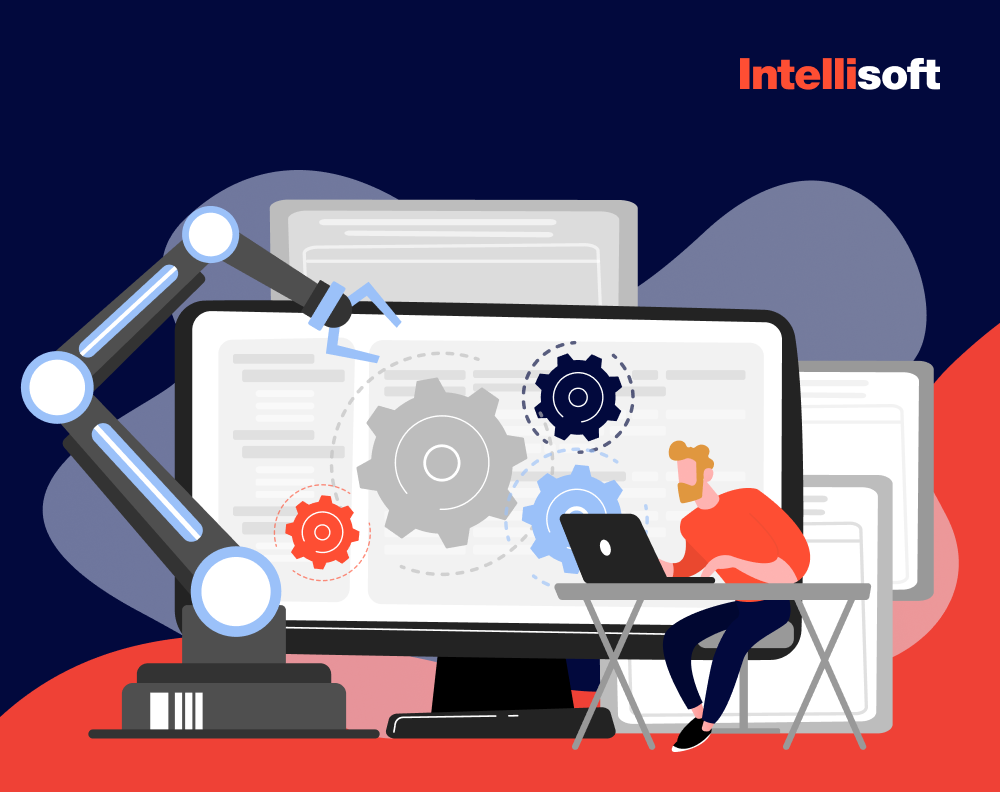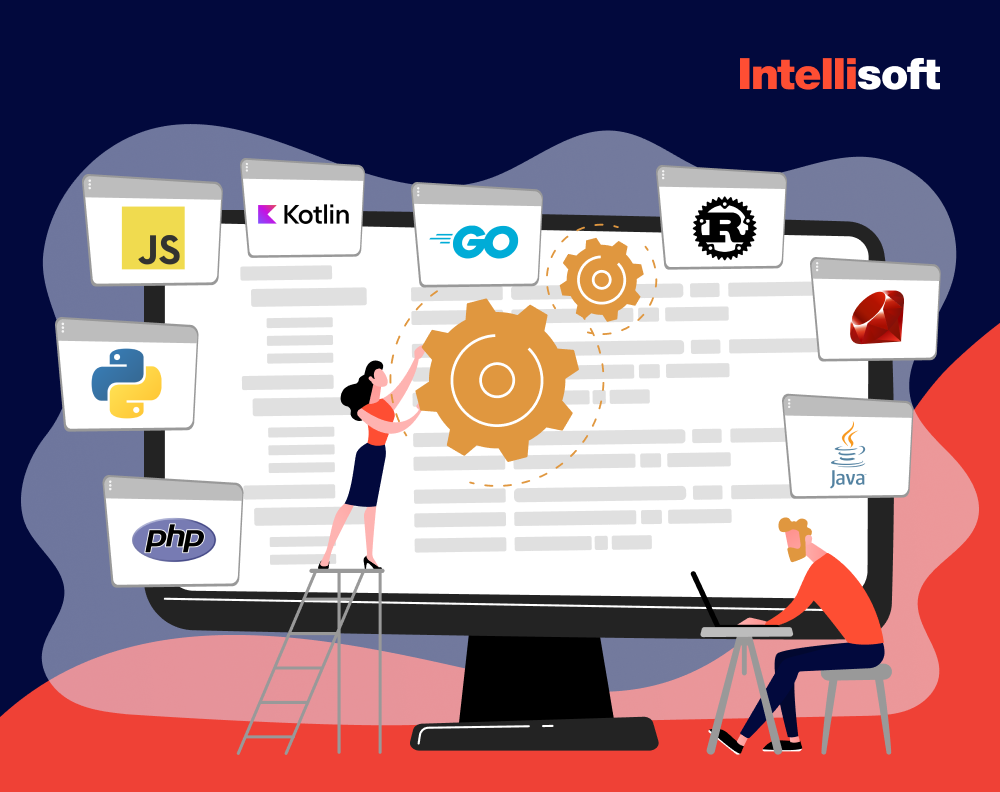In today’s dynamic industrial environment, optimizing operational efficiency and minimizing downtime are critical objectives. Traditional reactive maintenance methods are inadequate for meeting the evolving needs of modern industries.
Predictive maintenance (PdM) software is a novel technology that has the potential to revolutionize maintenance procedures. AI software predictive maintenance solutions enable firms to anticipate equipment breakdowns ahead of time by leveraging the power of sophisticated data analytics and machine learning algorithms. These systems can predict possible problems before they arise by analyzing enormous volumes of data, which enables planned maintenance schedules and major savings in expensive downtime.
In this article, you’ll uncover the transformative potential of PdM software in revolutionizing your industrial operations. As you strive for competitiveness in today’s market, adopting innovative technologies is essential. With over 15 years of expertise in software development, IntelliSoft is here to empower you in leveraging PdM, enhancing your operational efficiency, and driving sustainable growth.
Table of Contents
What is Predictive Maintenance Software?
In the realm of modern industrial management, PdM software stands out as a critical tool for optimizing operational efficiency and minimizing downtime. But what exactly is predictive maintenance software meaning, and how can it benefit your business?
Predictive Maintenance Software Definition
Predictive maintenance software is a sophisticated technological solution designed to forecast potential equipment failures before they occur.
By leveraging advanced data analytics, machine learning algorithms, and sensor data from industrial machinery, this software can detect patterns and anomalies indicative of impending issues. Rather than relying on reactive strategies or fixed schedule-based approaches, PdM empowers businesses to proactively address needs, thereby preventing costly downtime and optimizing resource allocation.
At its core, PdM enables you to move away from the traditional “break-fix” model towards a more proactive and strategic approach.
By continuously monitoring equipment health in real-time, this software provides actionable insights that allow you to prioritize maintenance tasks based on actual equipment conditions rather than arbitrary schedules.
This predictive capability extends the lifespan of your assets and reduces the likelihood of unexpected breakdowns, ultimately improving overall operational reliability.
The Difference Between Predictive Maintenance and Preventive Maintenance
While both predictive maintenance (PdM) and preventive maintenance (PM) aim to maintain equipment reliability and minimize downtime, they operate on fundamentally different principles.
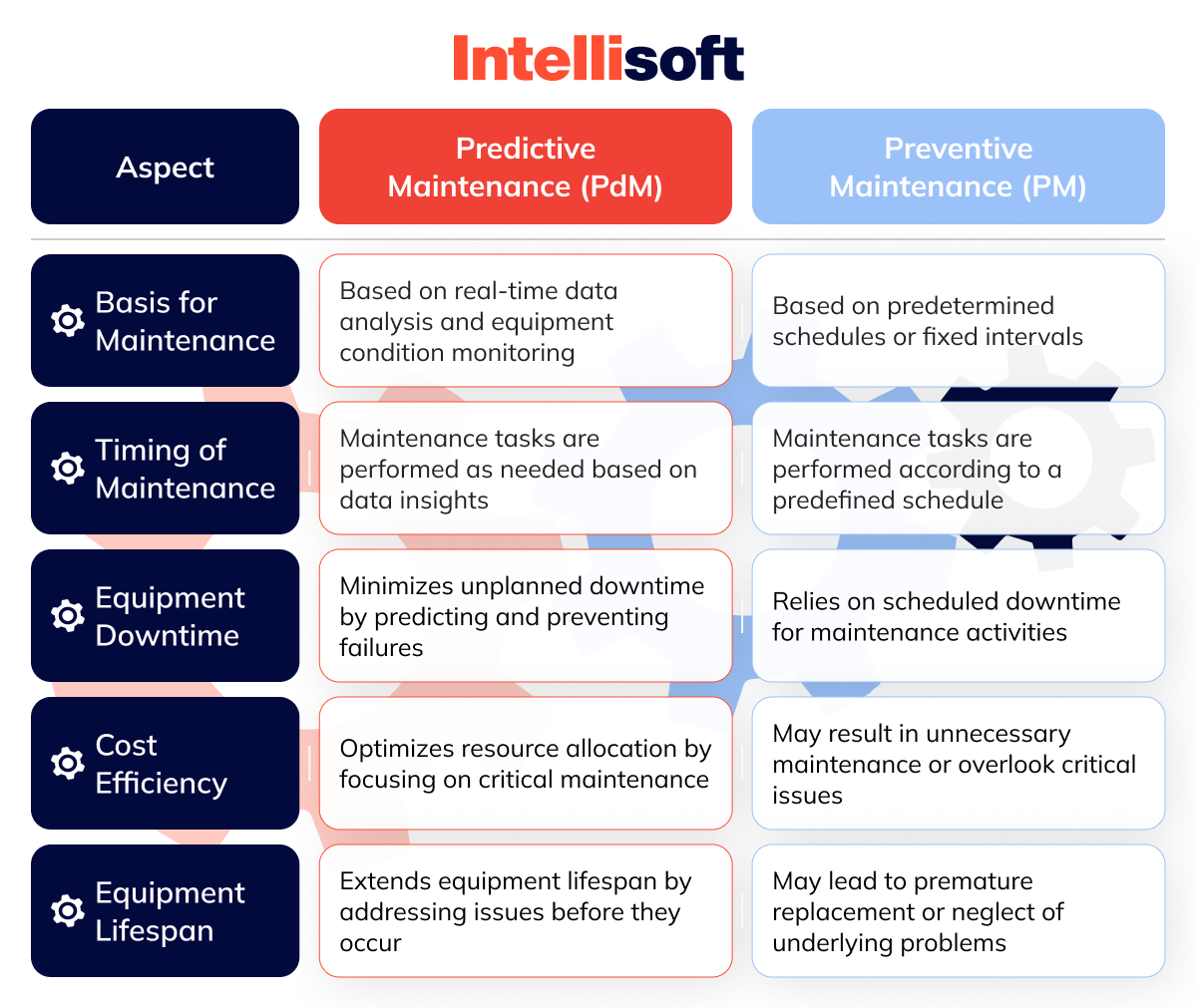
While preventive maintenance provides a general framework for upkeep, PdM offers a more proactive and targeted approach, ensuring that efforts are deployed precisely where and when they are needed most. By understanding the distinction between these two maintenance strategies, businesses can make informed decisions regarding their maintenance practices to maximize operational efficiency and equipment reliability.
How Does Predictive Maintenance Software Work?
PdM operates on the principle of leveraging data-driven insights to anticipate and prevent equipment failures before they occur.
The process typically involves several key steps:
The initial phase entails the collection of data, a crucial step in the predictive maintenance (PdM) process. This involves sourcing information from various channels such as predictive maintenance software devices, sensors, Internet of Things (IoT) devices, and historical maintenance records. These diverse data sources provide insights into potential signs of failure, operational conditions, and equipment performance.
Subsequently, the collected data undergoes thorough analysis in the second step of the process. Sophisticated analytical techniques, including machine learning algorithms, are employed to scrutinize the data and discern patterns, anomalies, and trends. By comparing current data with historical trends, the program can detect deviations that may signify impending equipment failures. This analytical approach helps in proactive maintenance planning and mitigating potential downtime.
Next is condition monitoring. PdM continuously monitors the condition of equipment in real-time, using the insights gleaned from data analysis to assess the health and performance of assets. This ongoing monitoring allows for early detection of abnormalities or signs of deterioration.
Failure prediction is the next step. Based on the analysis of data and condition monitoring results, PdM can predict potential equipment failures with a high degree of accuracy. By identifying early warning signs and patterns associated with past failures, the software can forecast when a component is likely to malfunction or require maintenance.
Step five is proactive maintenance. Armed with predictive insights, teams can take proactive measures to address potential issues before they escalate into costly failures. Maintenance tasks can be scheduled strategically during planned downtime periods, minimizing disruption to operations and maximizing equipment uptime.
Finally – continuous improvement. PdM is a continuous process that allows for ongoing refinement and optimization. By continuously collecting and analyzing data, adjusting algorithms, and incorporating feedback from activities, organizations can refine their PdM strategies over time to further enhance reliability and efficiency.
Key Elements For Predictive Maintenance Software
The best predictive maintenance software relies on several crucial elements, including advanced technologies like condition-monitoring sensors and the Internet of Things (IoT):
- Condition-monitoring sensors: These sensors continuously monitor the health and performance of equipment in real-time, providing valuable data on factors such as temperature, vibration, pressure, and fluid levels.
- Internet of Things (IoT) connectivity: IoT enables seamless communication between devices and systems, facilitating the collection and transmission of data from sensors to the predictive maintenance software platform.
- Data analytics and machine learning algorithms: Advanced analytics techniques, including machine learning algorithms, analyze the vast amount of data collected from sensors to identify patterns, anomalies, and trends indicative of potential equipment failures.
- Predictive modeling: Predictive models leverage historical data and insights from analytics to forecast when equipment is likely to fail, allowing for proactive maintenance planning and scheduling.
- Integration with existing systems: Seamless integration with existing enterprise resource planning (ERP), asset management, and maintenance systems ensures streamlined operations and data sharing across the organization.
- Real-time monitoring and alerts: The software provides real-time monitoring of equipment health and sends alerts or notifications to maintenance teams when anomalies or potential failures are detected, enabling prompt action.
- Scalability and flexibility: Predictive maintenance software should be scalable to accommodate growing datasets and adaptable to different types of equipment and industries, ensuring its effectiveness in various operational environments.
- User-friendly interface: An intuitive interface makes it easy for maintenance personnel to access and interpret data, enabling informed decision-making and efficient maintenance workflows.
- Cost-effectiveness: The software should offer a favorable return on investment by reducing unplanned downtime, minimizing maintenance costs, and optimizing equipment lifespan.
- Continuous improvement: Regular updates, feedback mechanisms, and iterative improvements ensure that the predictive maintenance software evolves to meet changing industry needs and technological advancements.
Predictive Maintenance Modeling and Algorithms
PdM employs various modeling techniques and algorithms, each with its strengths and limitations. Here are three key approaches and their respective components:
Machine Learning (ML)
- In supervised learning, algorithms are trained using labeled data, where input features are associated with known outcomes, such as equipment failure or non-failure. Classification algorithms are employed to predict discrete outcomes, such as failure or non-failure, while regression algorithms predict continuous outcomes such as time until failure. Supervised learning excels at recognizing patterns in data but necessitates labeled training data, which can be costly or challenging to acquire.
- Conversely, unsupervised learning algorithms identify patterns in data without labeled examples. Clustering algorithms group similar data points together, while anomaly detection algorithms pinpoint outliers or anomalies within the data. Unsupervised learning is particularly useful for detecting unknown patterns or anomalies but may face challenges in interpreting the significance of detected patterns without human intervention.
Limitations of predictive maintenance AI software:
Machine learning algorithms require large amounts of high-quality labeled data for training, which may not always be available in predictive maintenance applications.
Rule-Based Approaches
- If-Then Rules. Rule-based systems use a set of logical if-then rules to make predictions or decisions based on input conditions. These rules are typically derived from expert knowledge or domain-specific heuristics and can be easily interpreted by humans. If-then rules provide transparency and explainability but may lack the flexibility to adapt to complex or dynamic environments.
- Expert Systems. Expert systems are rule-based systems that mimic the decision-making processes of human experts in a specific domain. They encode expert knowledge into a knowledge base and use inference engines to make decisions or recommendations. Expert systems are valuable for capturing and leveraging domain expertise but may struggle to handle uncertain or ambiguous information.
- Fault Trees. Fault trees are graphical representations of system failure modes and their causes, constructed using a combination of logical gates (e.g., AND, OR). Fault trees enable systematic analysis of potential failure scenarios and their probabilities, aiding in risk assessment and mitigation. However, fault trees may become complex and unwieldy for large or interconnected systems.
Statistical Analysis
- Regression Models. Regression analysis models the relationship between one or more input variables (e.g., sensor readings) and a continuous output variable (e.g., time until failure). Regression models can provide insights into the quantitative impact of input factors on equipment reliability but may assume linear relationships that may not hold in practice.
- Time Series Analysis. Time series analysis examines data collected over time to identify patterns, trends, and seasonality. Techniques such as autoregressive integrated moving average (ARIMA) models and exponential smoothing are used to forecast future values based on historical data. Time series analysis is well-suited for predicting future equipment performance but may require stationary data and may not capture complex interactions between variables.
- Survival Analysis. Survival analysis models the time until a specific event occurs, such as equipment failure or maintenance. It accounts for censoring (i.e., incomplete observation) and allows for the estimation of survival probabilities over time. Survival analysis is particularly useful for analyzing time-to-event data but may require assumptions about the underlying distribution of failure times.
Where is PdM Used?
PdM finds application across various industries and sectors where the reliability and uptime of equipment are critical. Some common areas where PdM is extensively used include:
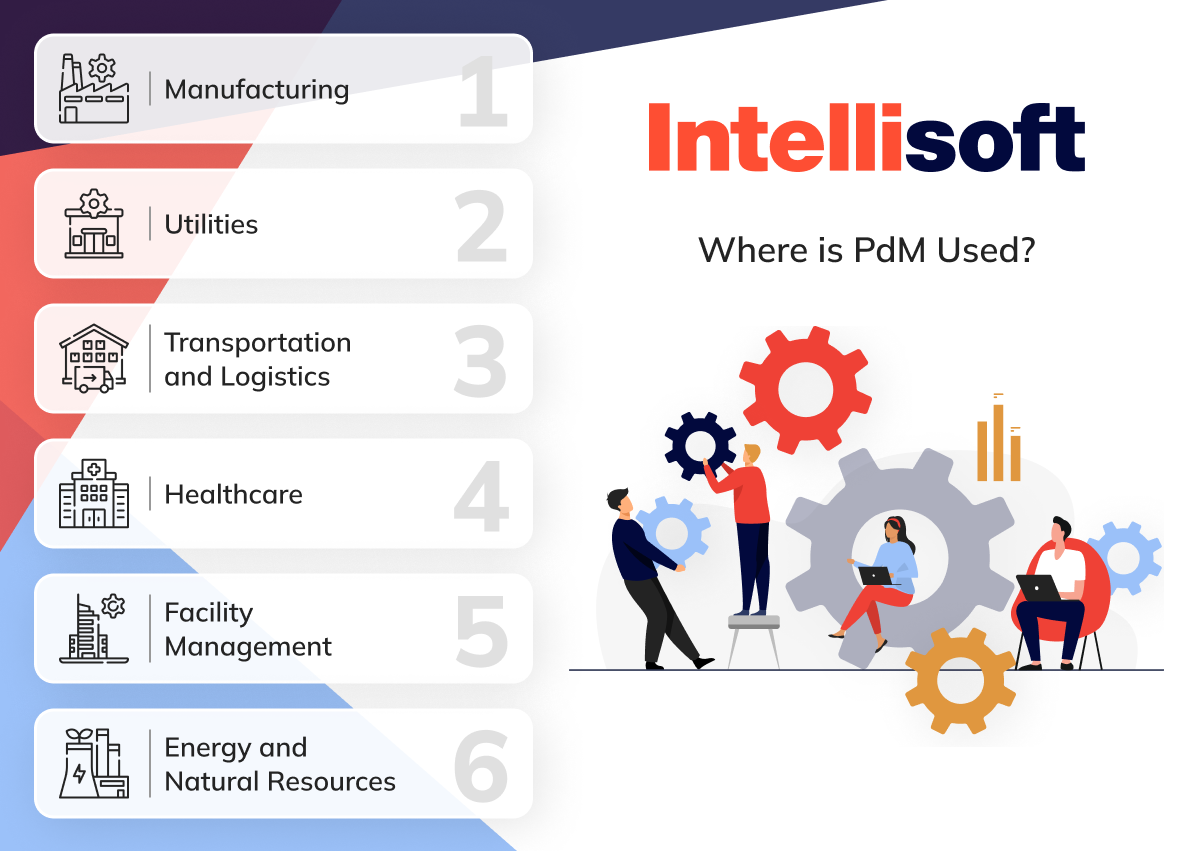
Manufacturing. Within manufacturing facilities, the implementation of manufacturing predictive maintenance software plays a pivotal role in the upkeep of critical production machinery, including CNC machines, robotics, conveyors, and assembly lines. This software enables the proactive monitoring of equipment health, facilitating the prediction of potential failures before they occur.
By leveraging predictive maintenance software, manufacturers can schedule maintenance activities strategically, aligning them with planned downtime periods. This approach minimizes production disruptions and maximizes throughput, ensuring seamless operations and optimal efficiency within the manufacturing environment. Ultimately, predictive maintenance software empowers manufacturers to maintain a competitive edge by reducing downtime, enhancing productivity, and optimizing resource utilization.
Utilities. In the utilities sector, including power plants, water treatment facilities, and oil refineries, predictive maintenance software oil and gas is essential for monitoring critical equipment such as turbines, pumps, generators, and pipelines. By leveraging this technology, utilities can proactively identify potential failures and optimize maintenance schedules. This proactive approach ensures uninterrupted service delivery and helps prevent costly outages, maintaining the reliability and efficiency of essential infrastructure.
Transportation and Logistics. In transportation and logistics, predictive maintenance is utilized to monitor the health of vehicles, aircraft, trains, and other transportation assets. By accurately predicting maintenance needs and scheduling repairs preemptively, transportation companies can uphold fleet reliability, enhance safety standards, and minimize service disruptions. This proactive approach contributes to maintaining operational efficiency and customer satisfaction within the transportation industry.
Healthcare. Within healthcare facilities, predictive maintenance plays a crucial role in monitoring and maintaining critical medical equipment such as MRI machines, X-ray machines, and laboratory instruments. By ensuring the uptime and reliability of medical equipment, healthcare providers can deliver timely and high-quality patient care. Predictive maintenance helps minimize downtime-related delays or cancellations, ensuring that healthcare facilities operate smoothly and effectively to meet the needs of patients.
Facility Management. PdM is employed in facility management to monitor and maintain building systems such as HVAC (heating, ventilation, and air conditioning), elevators, lighting, and security systems. By predicting equipment failures and optimizing maintenance schedules, facility managers can ensure the safety, comfort, and operational efficiency of building occupants.
Energy and Natural Resources. PdM is used in the energy and natural resources sector to monitor and maintain equipment such as drilling rigs, pumps, compressors, and pipelines. By proactively identifying potential failures and optimizing maintenance activities, energy companies can maximize operational uptime, reduce maintenance costs, and minimize environmental risks.
Benefits of Predictive Maintenance
PdM offers numerous advantages for businesses across various industries, enhancing operational efficiency and minimizing costly disruptions. Here are some key benefits:
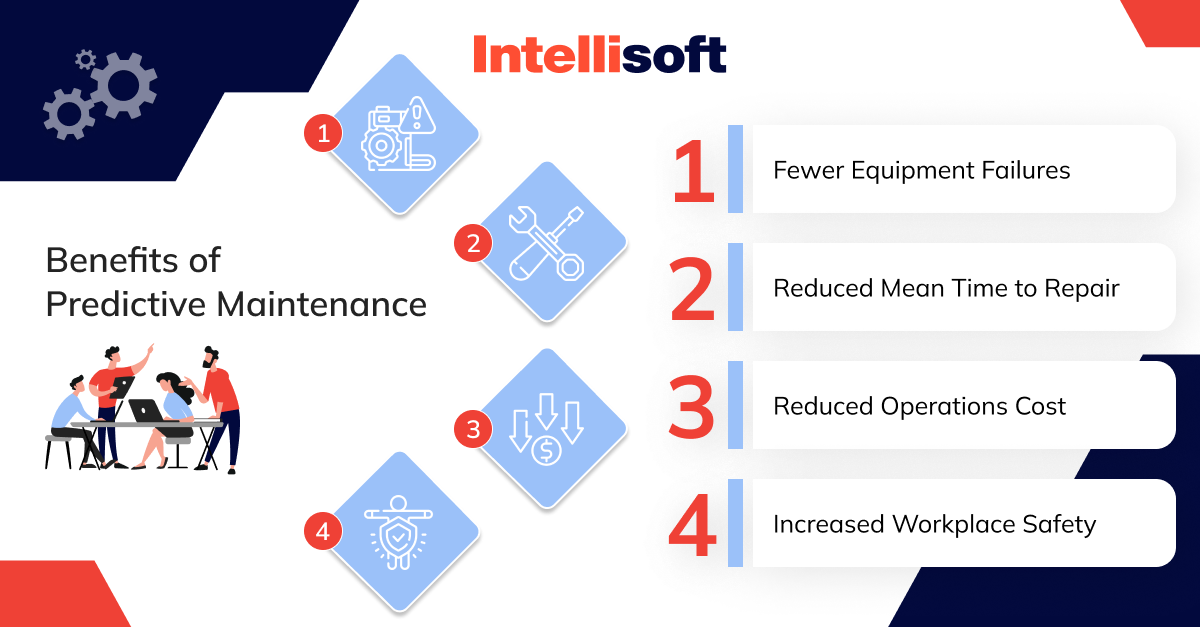
Fewer Equipment Failures
One of the most significant benefits of PdM is its ability to anticipate and prevent equipment failures before they occur.
By continuously monitoring equipment health and analyzing real-time data, PdM can detect subtle signs of impending issues, allowing maintenance teams to intervene proactively.
This proactive approach significantly reduces the likelihood of unexpected breakdowns and unplanned downtime, which can disrupt operations, delay production schedules, and incur significant costs.
With PdM, organizations can maintain a higher level of operational reliability, ensuring that critical equipment remains in optimal condition and delivering consistent performance over time.
Reduced Mean Time to Repair
In addition to preventing equipment failures, PdM also helps organizations streamline their maintenance processes and minimize repair times.
By identifying maintenance needs based on actual equipment condition rather than arbitrary schedules, maintenance teams can prioritize tasks and allocate resources more efficiently.
Early detection of potential issues allows for timely intervention and proactive maintenance actions, reducing the severity of problems and preventing them from escalating into major failures.
As a result, the mean time to repair (MTTR) is significantly reduced, enabling organizations to minimize downtime, maintain operational continuity, and maximize productivity.
By addressing maintenance needs promptly and efficiently, PdM ensures that equipment downtime is kept to a minimum, allowing businesses to meet production targets, fulfill customer demands, and maintain a competitive edge in the market.
Reduced Operations Cost
PdM offers substantial cost savings by optimizing maintenance practices and resource allocation.
By preventing unplanned downtime and minimizing the need for costly emergency repairs, organizations can reduce the direct costs associated with equipment failures, such as repair expenses, replacement parts, and labor costs.
Moreover, PdM enables better planning and utilization of maintenance resources, ensuring that resources are allocated effectively and efficiently. Maintenance tasks can be scheduled during planned downtime periods, maximizing the use of available resources and minimizing idle time.
Additionally, PdM helps organizations extend the lifespan of their assets by addressing maintenance needs proactively, reducing the frequency of replacements and capital expenditures.
Increased Workplace Safety
PdM contributes to increased workplace safety by minimizing the risk of equipment failures and accidents. By proactively identifying and addressing potential safety hazards, such as equipment malfunctions or failures, organizations can create a safer work environment for employees. Reduced downtime and disruptions also contribute to improved safety by maintaining operational continuity and preventing rushed or unsafe maintenance procedures.
Related readings:
- Supply Chain Data Analytics for Efficient Operations
- IoT in Oil and Gas Industry: Future of Energy Technologies
- Fuel Management System: A Step-by-Step Development Guide
- How To Control IoT Devices To Reach Your Business Goals
- IoT Connectivity Options: Roadmap to Smart Solutions
The Return On Investment Of Predictive Maintenance
Predictive maintenance (PdM) is not just a cost-saving measure; it’s an investment in the future of your business.
By proactively monitoring equipment health, predicting potential failures, and optimizing maintenance schedules, PdM delivers a significant return on investment (ROI) across various dimensions of operations.
Let’s explore how investing in predictive maintenance can yield substantial returns for your organization:
Maximized Equipment Uptime and Production Output
One of the most significant returns on investment from PdM comes in the form of maximized equipment uptime and production output. By preventing unexpected breakdowns and minimizing unplanned downtime, predictive maintenance ensures that critical equipment remains operational when needed most.
This maximization of uptime enables organizations to meet production targets, fulfill customer demands, and capitalize on revenue-generating opportunities without disruptions or delays. The ability to maintain continuous operations translates directly into increased productivity, output, and revenue generation for the business.
Reduced Maintenance Costs and Expenditures
Predictive maintenance enables organizations to optimize their maintenance practices and resource allocation, resulting in substantial cost savings over time. By detecting and addressing maintenance needs proactively, PdM minimizes the need for costly emergency repairs, replacement parts, and overtime labor.
Additionally, by extending the lifespan of equipment and reducing the frequency of replacements, PdM helps organizations save on capital expenditures and asset lifecycle costs. The ability to reduce maintenance costs and expenditures directly improves the organization’s bottom line and enhances overall financial performance.
Improved Asset Reliability and Performance
Predictive maintenance software for asset management leads to improved operational efficiency and effectiveness. By addressing maintenance needs based on actual equipment condition and performance data, predictive maintenance ensures that assets remain in optimal working condition, delivering consistent performance over time.
This reliability and performance optimization translate into increased operational efficiency, reduced waste, and improved quality of products or services. Additionally, by minimizing equipment failures and downtime, PdM enhances asset availability and utilization, maximizing the return on investment in capital assets.
Enhanced Safety, Compliance, and Reputation
PdM contributes to enhanced workplace safety, regulatory compliance, and brand reputation, delivering intangible returns that are equally valuable. By proactively identifying and addressing potential safety hazards, PdM helps create a safer work environment for employees, reducing the risk of accidents, injuries, and incidents.
This prioritization of safety not only protects employees but also ensures compliance with industry regulations and standards, mitigating legal and reputational risks for the organization.
Moreover, by maintaining high standards of reliability, performance, and operational excellence, PdM enhances the organization’s reputation as a trusted and responsible provider of products or services, fostering customer loyalty and competitive advantage.
Long-Term Sustainability and Growth
Ultimately, investing in PdM is an investment in the long-term sustainability and growth of your business. By optimizing asset performance, minimizing downtime, and reducing maintenance costs, PdM enables organizations to operate more efficiently, competitively, and profitably in the long run.
The returns on investment from PdM extend beyond immediate cost savings to encompass broader benefits such as increased market share, customer satisfaction, and shareholder value. By embracing PdM as a strategic investment in the future, organizations position themselves for sustained success and growth in an increasingly competitive and dynamic business environment.
Key Industrial IoT Platforms Supporting PdM
In the realm of PdM, Industrial Internet of Things (IoT) platforms play a pivotal role in enabling real-time monitoring, data analytics, and predictive capabilities for industrial equipment. Here are three prominent Industrial predictive maintenance software supporting platforms:
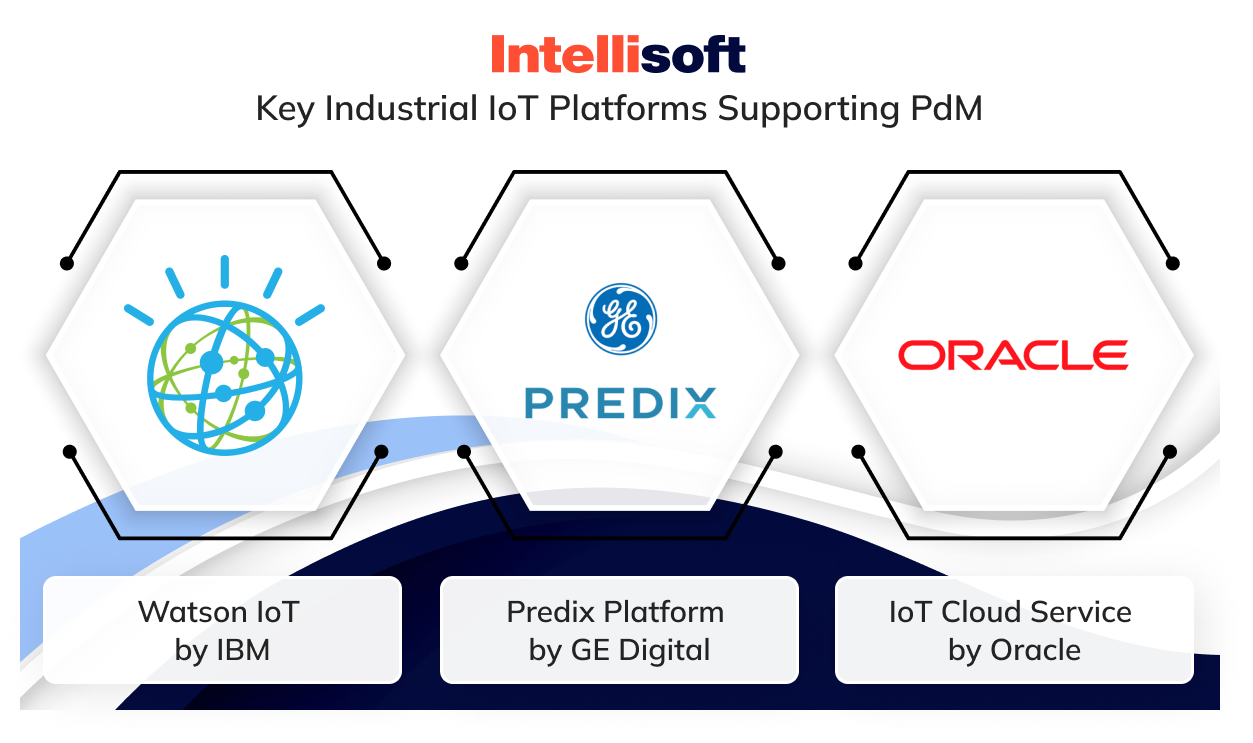
Watson IoT by IBM
Watson IoT is an advanced Industrial IoT platform developed by IBM, offering comprehensive solutions for asset management, PdM, and operational optimization.
Leveraging AI-powered analytics and machine learning algorithms, Watson IoT enables organizations to collect, analyze, and act on data from connected devices and equipment in real-time.
With its PdM capabilities, Watson IoT helps businesses proactively identify equipment failures, optimize maintenance schedules, and minimize downtime, thus maximizing operational efficiency and asset reliability.
Predix Platform by GE Digital
Predix Platform, developed by GE Digital, is a leading Industrial IoT platform designed specifically for industrial applications such as manufacturing, energy, and healthcare.
With its robust suite of tools and services, Predix Platform enables organizations to build, deploy, and manage industrial IoT applications at scale.
Predix Platform offers advanced analytics, machine learning, and PdM capabilities, allowing businesses to monitor equipment health, predict potential failures, and optimize maintenance strategies.
By harnessing the power of Predix Platform, organizations can drive operational excellence, reduce maintenance costs, and improve asset performance.
IoT Cloud Service by Oracle
Oracle IoT Cloud Service is a comprehensive Industrial IoT platform that enables organizations to connect, analyze, and manage IoT data from a wide range of devices and sensors.
With its scalable architecture and advanced analytics capabilities, Oracle IoT Cloud Service empowers businesses to gain actionable insights from IoT data, including PdM insights.
By leveraging machine learning algorithms and predictive analytics, Oracle IoT Cloud Service helps organizations identify patterns, anomalies, and trends in equipment data, enabling proactive maintenance actions and minimizing downtime. With its robust features and integration capabilities, Oracle IoT Cloud Service provides a solid foundation for implementing PdM strategies and optimizing asset performance.
6 Steps to Implement PdM
Implementing a PdM strategy requires careful planning, coordination, and execution to ensure its success. Here are six essential steps to guide you through the process:
Step 1. Identify Priority Assets
The first step in implementing a PdM strategy is to identify and prioritize the assets that are critical to your operations. Assess your equipment inventory and determine which assets have the greatest impact on production, safety, and profitability. Focus on high-value assets with a history of failures or those whose downtime would have significant consequences. By prioritizing assets, you can allocate resources more effectively and tailor your PdM efforts where they will yield the most significant benefits.
Step 2. Start Training Staff
Training your staff is essential to ensure they have the knowledge and skills required to support the implementation of PdM. Provide training on the principles of PdM, including data analysis, condition monitoring techniques, and the use of PdM tools and software. Engage maintenance technicians, operators, and other relevant personnel in the training process to foster buy-in and collaboration. By investing in training and development, you empower your team to effectively implement and sustain the PdM strategy over the long term.
Step 3. Set Condition Baselines
Establishing condition baselines for your assets is crucial for monitoring and detecting deviations from normal operating conditions. Define key performance indicators (KPIs) and thresholds for each asset based on historical data, manufacturer specifications, and industry best practices. These condition baselines serve as benchmarks for assessing equipment health and identifying potential issues. By setting clear and measurable condition baselines, you can effectively monitor asset performance and prioritize maintenance activities accordingly.
Step 4. Install Condition-Monitoring Devices & Sensors
Deploying condition-monitoring devices and sensors is essential for collecting real-time data on equipment health and performance. Install sensors to monitor critical parameters such as temperature, vibration, pressure, and fluid levels, depending on the specific requirements of each asset. Choose sensors that are compatible with your equipment and capable of providing accurate and reliable data. By capturing comprehensive data from condition-monitoring devices, you can gain insights into equipment condition and behavior, enabling proactive maintenance actions and early detection of potential failures.
Step 5. Connect Devices to a CMMS
Integrating condition-monitoring devices with a computerized maintenance management system (CMMS) is vital for streamlining data collection, analysis, and maintenance workflows. Ensure that your CMMS is capable of receiving data from sensors in real-time and processing it effectively. Establish protocols for data transmission, storage, and retrieval to ensure data integrity and accessibility. By connecting devices to a CMMS, you can centralize maintenance data, track equipment performance, and generate actionable insights to support PdM decision-making.
Step 6. Initiate Your PdM Strategy
With all the necessary elements in place, it’s time to initiate your PdM strategy. Develop a comprehensive plan outlining maintenance tasks, schedules, and protocols based on the insights gained from condition monitoring and analysis. Implement PdM practices such as condition-based monitoring, predictive analytics, and proactive maintenance interventions. Continuously monitor equipment health, analyze performance trends, and adjust your maintenance strategy as needed to optimize asset reliability and minimize downtime. By initiating your PdM strategy, you embark on a journey towards operational excellence, cost savings, and improved asset performance.
Conclusion
In conclusion, PdM presents a transformative approach to asset management, offering organizations the ability to preemptively address equipment issues, minimize downtime, and optimize maintenance costs.
At IntelliSoft, we recognize the critical importance of PdM in today’s dynamic business landscape. With over 15 years of expertise in software development, our team is poised to support your PdM journey.
From identifying priority assets to deploying cutting-edge condition-monitoring sensors and seamlessly integrating with your existing systems, IntelliSoft offers tailored solutions to meet your specific needs.
By partnering with us, you gain access to innovative tools and strategies designed to enhance asset reliability, drive operational efficiency, and propel your business forward.
Contact IntelliSoft today to explore how we can collaborate to implement a robust predictive maintenance strategy and achieve sustainable growth and success. Let us help you harness the power of predictive maintenance to unlock new opportunities and stay ahead in today’s competitive market.






